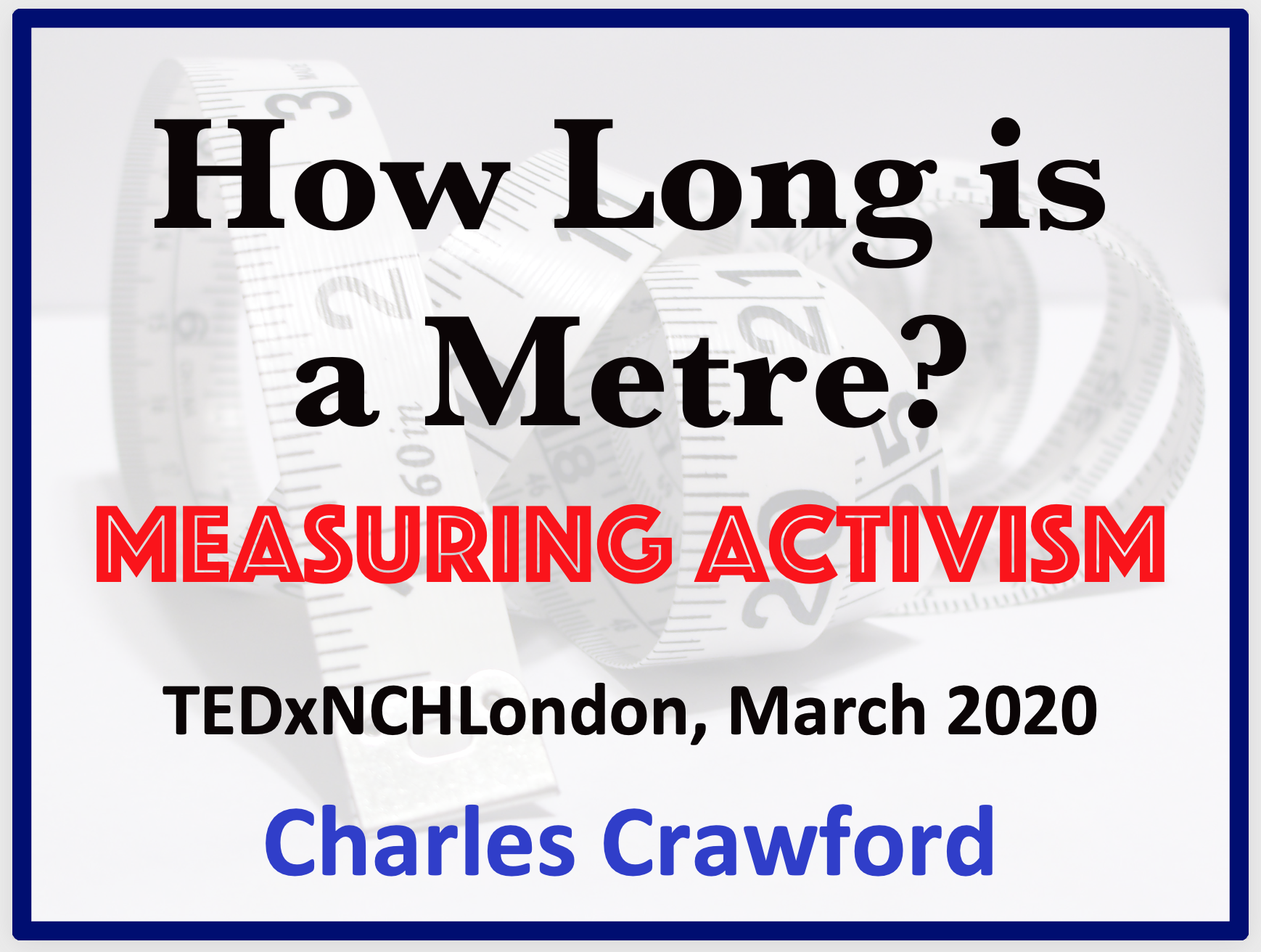So, there I was all set to plunge into the fray at TEDxNCHLondon to opine on the broad if oddly titled subject of Activism in the Modern Day when the event was postponed for COVID19 reasons.
I even had my snazzy PowerPoint more or less ready:
Wait! How long is a metre? What sort of question is that? It’s a metre long, of course!
Ah. Not so fast.
Why is what we think of as a metre-long as long as it in fact is? Why is it not rather shorter or rather longer? Or a lot shorter or longer?
The wily French some 200 years ago measured the distance between the equator and the North Pole via the ‘great circle’ and proclaimed that a small fraction of that distance was ‘one metre’. Once that length was accepted it could be turned into other lengths (eg ‘centimetres’ and ‘kilometres’).
Standardised ways to measure length opened the way to standardised ways to measure area and volume. This in turn opened the way to measure weight (eg one cubic centimetre of water = one gramme) and density and so on. A metal metre bar was displayed in Paris as the one and only standard for all other metre measuring devices.
Why all this meticulous effort? In good part to standardise government and above all taxes! Different parts of France each had their own ways to measure things, so without a standard way to measure (say) the weight or volume of grain, taxes based on paying the state ‘a bag of grain’ were a mess. For a fine account of all this, see here.
The point was that any way to ‘define’ and then proclaim a ‘standard’ length had to be based on something arbitrary (in this case, the size of the Earth). Nowadays the standard metre is based on a fraction of the distance travelled by the speed of light – a robust universal constant (or so we think).
Anyway, in his Philosophical Investigations at #50 Ludwig Wittgenstein said something characteristically laconic that has spawned a lively philosophical literature all of its own (my emphasis):
There is one thing of which one can say neither that it is one metre long, nor that it is not one metre long, and that is the standard metre in Paris.—But this is, of course, not to ascribe any extraordinary property to it, but only to mark its peculiar role in the language-game of measuring with a metre-rule.
Let us imagine samples of colour being preserved in Paris like the standard metre. We define: “sepia” means the colour of the standard sepia which is there kept hermetically sealed. Then it will make no sense to say of this sample either that it is of this colour or that it is not.
In other words, it makes no sense to try to express the length of that metre bar in terms of metres, as the bar itself sets the standard for measuring in metres.
In all matters Wittgenstein, turn to Peter Hacker:
Since ‘a metre’ was defined as the length of the Standard Metre under specified conditions, to say that the Standard Metre is a metre long would be to say that it is as long as itself, ie to say nothing. And to say that the Standard Metre is not a metre long would be to say that it is not the length it is, ie to talk nonsense.
‘The Standard Metre Bar is a metre long’ is a definition, not a description attributing a length to that platinum-iridium bar. It is not a ‘metaphysical truth’ (and if it were, it would hardly be something that would-be metaphysicians could be proud of disclosing to the Royal Society as their contribution to our knowledge of reality). Nor is it a ‘contingent a priori truth’ – there is no such thing.
Rather, it is the expression of a rule. (It can be said to be true, but only after the fashion in which it can be said to be true that the chess king moves one square at a time.) Of course, we might have had a different rule and might have used a longer or shorter sample – but then ‘one metre’ would have had a different meaning. Similarly, the Standard Metre Bar might be stretched or compressed – but then we would not continue to use it as the standard, and would make a new Standard Metre Bar – we are, after all, not at the mercy of our sample.
If that doesn’t satisfy you, run a Google search on Wittgenstein metre and brace yourself to get dizzy.
Hmm. So, what if anything has all this to do with Activism?
My core idea was that you need a baseline test as a standard for anything you’re talking about: a test that shows whether what you’re saying makes sense.
And that much of today’s ‘activism’ has no such baseline and so (perhaps) risks being incoherent, misleading or dangerous. Thus when we’re talking about ‘racism’, what is a ‘race’? Or if we’re talking about ‘gender’, what’s the baseline for defining ‘men’ and ‘women’? What baseline makes sense when we’re talking about ‘stopping climate change’? If your baselines make no sense or are contradictory or confused, your noisy ‘demands’ will be the same.
Likewise bitter feuding between activists: do ‘men’ and ‘women’ exist, or is that very idea a ‘social construct’? If a ‘man’ can self-identify as a ‘woman’ and demand that under law s/he IS now a ‘woman’, why can’t a ‘white’ person self-identify as a ‘black’ person and demand all available minority rights privileges?
Likewise surely if anything is a ‘social construct’ surely ethnicity is. Might (say) an African self-identify as a Japanese and demand to be treated as such?
What’s the baseline test in such cases for measuring what categories exist and how our language and practice and laws deal with them? What claims make sense?
And so to #COVID19. Might the current lockdown and generalised confusion/panic across the globe be a case of ‘the cure is worse than the disease itself’? How to tell? What is the test for distinguishing success from failure or even from disaster?
When some smirky TV journalist asks a politician “Are you sure you’re getting the policy right?” what’s the test for ‘right’? Is it wise to obliterate whole areas of the economy and ruin countless people’s lives if there’s no clear answer to that?
BUT BUT BUT HUMAN LIVES ARE AT STAKE DON’T YOU CARE???
Fine. Now, what’s the test for measuring ‘caring’?
To be continued.











